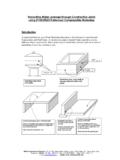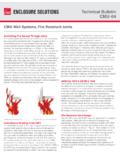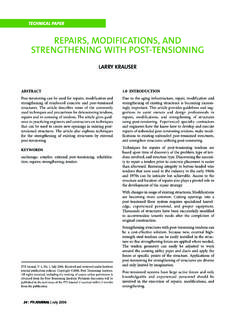Transcription of Learning the Difference Between 1/2-lb and 2-lb Spray ...
1 Page 1 Learning the Difference Between 1/2-lb and 2-lb Spray Polyurethane Foam By Mason Knowles, Executive Director Spray Polyurethane Foam Alliance S pray polyurethane foam (SPF) has be-come popular for its insulation value and air barrier The plastic material comes in two basic types 1/2-lb and 2-lb and both are used in insulation applica-tions as barriers in buildings. Both of these foams also can help control condensation within buildings and have other environ-mental benefits. Architects/engineers (A/Es) need to under-stand how the two foams are different .. and which one may be suited for a particular project. The first point is quite easily answered, but the second requires a more detailed analysis of the specific building s use, construction type, environment, and other general characteristics. 1/2-lb SPF refers to generic Spray polyure-thane foam weighing Between and lb/ft3 when fully cured.
2 Spray -applied to a substrate, it expands about 150 times its original volume to form a semi-rigid, non-structural plastic. This SPF typically has an R-value of approximately per inch and Left, 1/2-lb SPF is sprayed in one pass Between wood studs. It slightly overfills the cavity, but is trimmed flush to the studs. Right, 2-lb SPF can be applied in multiple lifts to achieve various thicknesses for desired R-value and air barrier performance. 1 As Spray foam formulations vary from manufacturer to manufacturer, specifiers should consult the suppliers Spray foam specification sheets to understand the exact properties. Page 2 typically uses water as the blowing agent. R-value measures resistance to heat flow the higher the R-value, the greater the insulating power. 2-lb SPF, on the other hand, weighs Between and 2 lb/ft3 when fully cured.
3 The material is used in interior applications, Spray -applied to a substrate, before expanding about 35 to 50 times its original volume, and forming a rigid plastic with a compressive strength Between 15 and 25 psi. This SPF has an (aged) R-value of around 6 per inch and relies on HCFCs (hydrochloro-fluorocarbons) or HCFs (hydrofluro-carbons) as its blowing agent. Spray Foam Similarities As mentioned above, both the 1/2-lb and 2-lb SPFs share many common characteristics. These common qualities are detailed below. Chemical components Both 1/2-lb and 2-lb SPF are made from blended sys-tems of polyol resins, catalysts, surfactants, fire retardants, and blowing agents on the B-side, with polymeric MDI (methylene diphenyl diisocyanate) on the A-side. The Difference Between SPF types is in how these materials are formulated just as a baker makes dozens of different breads using water , yeast, and various flours, the SPF systems manufacturer creates several different SPFs from only a few ingredients.
4 Sealing characteristics The air barrier system within the building envelope is an important element for controlling moisture/heat transfer, and for preserving structural integrity. Inadequate air barrier systems allow leakage of air through holes, cracks, and gaps in the building enve-lope. Field experience shows properly installed SPF can help significantly improve the energy efficiency of buildings when used as an air leakage control and insulation system. Since 1/2-lb and 2-lb SPF is applied as a liquid, it expands in all directions, filling and effectively sealing hundreds of cracks in walls, ceilings, corners, joints, and penetrations that would otherwise allow air ingress. Thermal barriers All SPF plastic insulation is required by build-ing codes to have a 15-minute thermal barrier covering the insulation on interior applica-tions, unless the application is exempted in the code or the application has been approved by a building code official.
5 Approval in this case would be based on full-scale fire tests specific to the particular situation. Spray foam, like most other organic materials, is combustible. It is formulated with flame retardants to decrease the flame spread as measured by ASTM E 84, Test for Surface Burning Characteristics for Building Materials, and other tests. However, these flame spread ratings are used solely to measure and describe properties of products in response to heat and flame under controlled laboratory conditions, rather than reflect hazards presented under actual fire conditions. Generally accepted tests for thermal barriers and building assemblies include: Both types of SPF can work well in most attics and cathedral ceilings without the need to ventilate (although one should follow the manufacturer s instructions). However, ventilation ducts can maintain desired temperatures more efficiently because they are in a conditioned space.
6 Page 3 ASTM E 119, Standard Test Methods for Fire Tests of Building Construction and Materials; Underwriters Laboratories Inc. (UL) 1715, Fire Test of Interior Finish Material; UL 1040, Insulated Wall Construction; FM Approval 4880, Class I Insulated Wall or Wall & Roof/Ceiling Panels; Plastic Interior Finish Materials; Plastic Exterior Building Panels; Wall/Ceiling Coating Systems; Interior or Exterior Finish Systems; and National Fire Protection Association (NFPA) 286, Methods for Fire Tests for Evaluating Contribution of Wall and Ceiling Interior Finish to Room Fire Growth. Safety and health issues Care should be exercised during the handling, processing, and application of SPF one must read the manufac-turers and suppliers material safety data sheets (MSDS), product labels, installation instructions, and also follow any local, state, or fed-eral regulations and requirements.
7 During the Spray foam application phase, aerosols are created that can be harmful to the applicator and those in the immediate vicinity of Spray operations. Application requires the appropriate use of personal pro-tective equipment by the installer to help avoid breathing fumes and keeping liquid compo-nents away from the skin or eyes. Care should also be taken to minimize exposure risk to building occupants during Spray operations. Cured SPF is relatively inert and has not been cited as a problem to allergy sufferers or to those with chemical sensitivities. Depending on the ventilation in place, odors and fumes can dissipate to non-detectable levels within minutes or hours of spraying. Determining the differences Between SPFs Despite the shared qualities Between 1/2-lb and 2-lb Spray polyurethane foams, it is each SPF type s unique properties that ultimately assist the A/E in selecting the proper material for his project, based on special site needs and priorities.
8 Installation 1/2-lb SPF is normally Spray -applied to the desired thickness with one pass, while 2-lb SPF is Spray applied at lifts from to inches until the desired total thickness is achieved. Excess foam can be trimmed easily with saws or knives, however, most applications do not require full stud thickness, meaning trimming is usually, unnecessary. For example, SPF installed at a 2-inch thickness Between 2x4 studs requires a minimal cleaning on the stud face. However, SPF installed to full stud thick-ness requires additional trimming with a specially designed trimming tool. Sound absorption Both 1/2-lb and 2-lb SPFs have air barrier qualities that can help reduce noise from out-side the building envelope ( airplanes and car traffic). The 1/2-lb foam s density offers additional sound absorbing qualities, however, neither foam is exceptionally effective at reduc-ing vibrational impact noises.
9 In the above curtain wall (CW) construction, 2-lb SPF is used to insulate the exterior of a building, helping to eliminate thermal bridging, while adding a secondary barrier against water penetration to the inside of the building. On the right, 2-lb SPF is used to achieve high R-value in a limited space. Page 4 Permeance Moisture has two primary means for entry into/ through the building envelope water vapor diffusion and air leakage . As men-tioned above, the excellent air barrier qualities of both 1/2-lb and 2-lb SPF helps effectively preclude the latter, however, the foam types differ when it comes to vapor diffusion. The higher the material s permeance, the faster water vapor can pass through . Con-trolling water vapor within a building is important for preventing condensation, mold growth, and subsequent damage to building components.
10 There are two basic types of moisture control within buildings: 1. The flow- through design, which allows water vapor to pass through the building assembly s components without condensing. 2. The vapor retarder design, which limits the moisture entering the building assembly altogether. A 1/2-lb SPF ranges Between 6 perms and 10 perms, with a 3-inch thickness of material. Its high permeability allows for the fairly rapid diffusion of water vapor, so the material often requires a vapor retarder element in the building assembly. In some cases, this could be part of the assembly, and requires no additional vapor retarder material. (When this is necessary, it is typically used on the insulation s warm side.) 2-lb SPF typically has a permeance of less than 1 perm at 3 inches, and can be used in flow- through designs without a vapor retarder.



